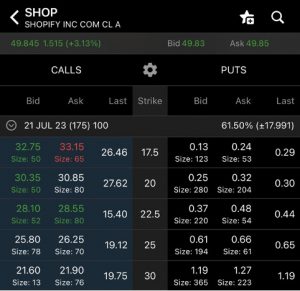The Game of Investing, Vol. 2
- Real Vision
- February 20, 2023

Welcome to The Game
The Game of Investing Newsletter…
…a bi-weekly newsletter where you learn from investing pros about how this game actually works.
Because learning about finance shouldn’t be boring.

This Week…
We’re talking options — and how they can help your portfolio when used correctly.
- “The whole point is to try to make options more approachable and more intuitive. I try to help people see that options are not as risky as they’re made out to be. In fact, they can help you manage your risk if you understand how to use them correctly.”
Imran just launched a 15-lesson options education course in the Real Vision Academy [paywall alert], so when you’re ready, go check that out. In the meantime, let’s build our foundation.
If you’re looking for a reliable way to elevate your investing education, look no further. Now you can access The Real Investing Course — part of the Real Vision Academy — without committing to an annual membership… and at 40% discount.
With thousands of hours of expert insights distilled into one 10-hour workshop, the course gives you all the tools you’ll need to navigate markets no matter the environment — with lessons from trading legends like Peter Brandt, Lyn Alden, Mike Green, Raoul Pal, and many more.
LEVEL 1 — The Groundwork
Options trading isn’t for everyone, but once you understand the basics, you’ll know if it could be a useful addition to your investment strategy.
By definition: An option is a contract giving the buyer the right but not the obligation to buy (via a “call”) or sell (via a “put”) the underlying asset at a specific price and by a specific expiration date.
- That specific price is called the “strike price.”
What Lies Beneath: Options are traded on everything from stocks and ETFs to bonds and commodities. Stocks are the most common, and 1 option contract represents the right to buy/sell 100 shares of the underlying stock.
Use Case: Some investors use options to generate income, while others do so to hedge risk.
- “Let’s say you’re short on capital, but you have a strong view,” says Imran. “Options give you a way to leverage that capital. You can put $1,000 down, you can have a 3-month view, and you can really participate in the upside if you get it right.”
Price Moves: As the underlying price changes, and as the expiration date approaches, the price of an option contract (aka “the premium”) will move in kind.
- Theoretically, call options gain value when the underlying rises, while put options gain value as the underlying falls.
- But as Imran explains, options are multi-dimensional. “The payoff depends not only on the direction of an asset but also the passage of time, which gives traders a way to take more specific positions.”
- Ultimately, it all comes down to probabilities. The more likely something is to occur, the more expensive an option that benefits from that outcome becomes.
⏳ Time Decay: Always keep the expiration date in mind. An option becomes less valuable as time passes because the probability of a favorable price move continues to diminish.
- Daily, weekly, and monthly expiry dates lose value much faster than contracts with plenty of time until expiration.
Level 2 — Read the Chain
Options chains might look Greek to you, but they’re actually pretty simple. A chain has 2 sections (calls and puts) with a list of strike prices and corresponding bids (buy offers), asks (sell offers), and last sale prices.
Below is the July 21, 2023, options chain for Shopify. At the top, you’ll note the stock ticker ($SHOP) and the current stock price ($49.845).

Calls are on the left, puts are on the right, and the middle column is our strike price. We also have our date of expiry:
- 21 Jul 23 (175) 100 = expiration date (days to expiry) 100 contracts.
Since the underlying stock price is currently much higher than the strike prices in this chain, the calls listed are worth much more than the puts.
- In this case, if you thought $SHOP was due for a correction, or if you owned the stock and wanted to hedge against downside risk, you could purchase puts at a $30 strike price for $127 (1.27 x 100 contracts).
✍️ Your Homework: Spend some time exploring options chains this week. Write down the dates, strike prices, and premiums, then track how they fluctuate. Take note of how the premiums behave during bouts of volatility. And what about when the stock is basing? See if you notice any patterns.
Next Time
Thanks for reading. We know options are tricky, so in Issue 3 we’ll be covering some more ground on them — and digging into exactly how Imran uses them in his own investing process.
The Game of Investing Newsletter…
…a bi-weekly newsletter where you learn from investing pros about how this game actually works.
Because learning about finance shouldn’t be boring.



